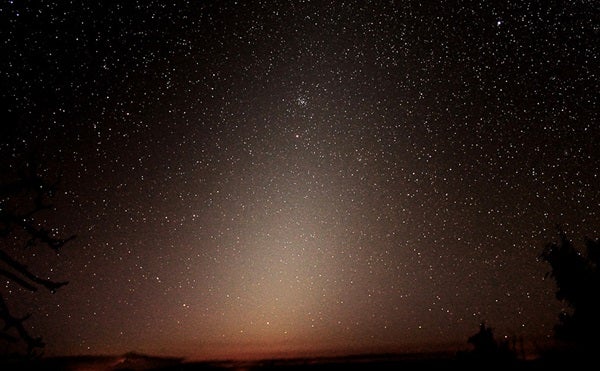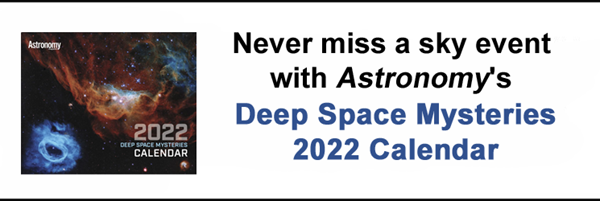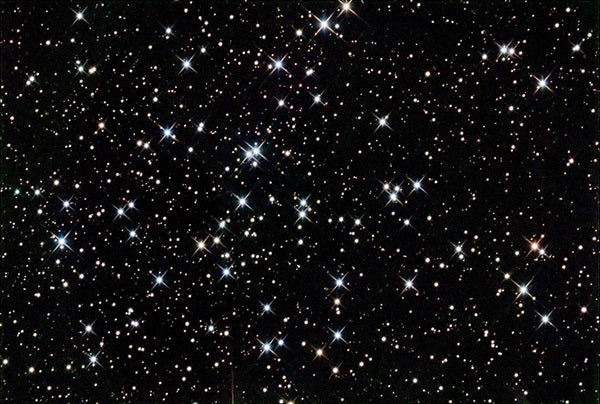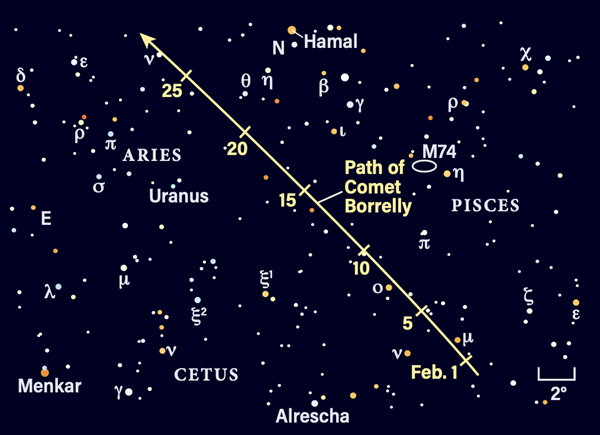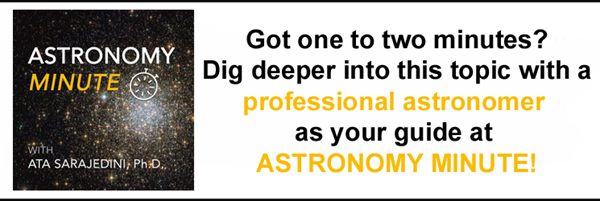Friday, January 28
Although there are no major meteor showers for the next two months, it doesn’t mean there isn’t something a little extra special to search for in the night sky. On moonless evenings like tonight, turn your gaze west an hour or so after sunset. If you’ve got a clear, dark observing site, you may just spot a yellow-white cone-shaped glow angling upward from the horizon, spreading steeply toward Taurus the Bull. It is visible by eye under good conditions and also photographs well.
This glow is the zodiacal light, created by sunlight scattering off myriad grains of dust spread throughout the solar system and aligned with the ecliptic (the plane of the solar system). Astronomers believe this dust is the debris left behind by countless comets approaching the Sun, although recent research suggests it may instead originate from the planet Mars.
One more thing astronomers have recently learned: Other planetary systems show evidence of zodiacal light as well. So, this close-to-home phenomenon may also light up the skies above alien life-forms on planets circling other stars.
Sunrise: 7:12 A.M.
Sunset: 5:15 P.M.
Moonrise: 3:56 A.M.
Moonset: 1:17 P.M.
Moon Phase: Waning crescent (17%)
*Times for sunrise, sunset, moonrise, and moonset are given in local time from 40° N 90° W. The Moon’s illumination is given at 12 P.M. local time from the same location.
Saturday, January 29
Venus stands stationary against the background stars of Sagittarius at 3 A.M. EST. You can catch the blazingly bright planet — now magnitude –4.8 — after it rises around 5 A.M. local time. You absolutely won’t be able to miss it, shining like a diamond in the still-dark sky.
Shortly after, Mars rises as well, a much fainter (but still easy-to-find) magnitude 1.4. Mars and Venus are just 10.5° apart, with a waning crescent Moon less than 3.5° south of the Red Planet, floating above the spout of Sagittarius’ famous Teapot asterism. The spout is formed by three stars: Delta (δ), Gamma (γ), and Epsilon (ϵ) Sagittarii. See how long you can follow these three luminaries into the brightening twilight before only the Moon and planets remain visible.
Later today, the Moon will pass 2° south of Mars at 10 A.M. EST and 10° south of Venus at 9 P.M. EST.
Sunrise: 7:11 A.M.
Sunset: 5:16 P.M.
Moonrise: 5:09 A.M.
Moonset: 2:15 P.M.
Moon Phase: Waning crescent (9%)
Sunday, January 30
The Moon reaches perigee, the closest point in its orbit to our planet, at 2:11 A.M. EST. At that time, it will sit just 225,093 miles (362,252 kilometers) away.
The Moon later passes 8° south of Mercury at 7 P.M. EST, but neither is visible then. Instead, intrepid skywatchers might catch them this morning, when the Moon has slid east through Sagittarius and is now 11.5° from Mercury. The two hang low in the southeast 30 minutes before sunrise. Our Moon is now a slim 4-percent-lit crescent, while Mercury shines to its upper left (northeast) at magnitude 1.7. Through a telescope, you’ll see that the small planet is 15 percent lit and spans 10″ on the sky.
Shining above them to the west (upper right) are Mars and Venus. Mars this morning sits less than 2° northwest of globular cluster M28; you’ll want to step outside a little earlier — an hour and a half to an hour before sunrise — to catch this pairing in binoculars or a wide-field scope. One other Messier globular cluster, M22, sits just over 4° due east of Mars.
Sunrise: 7:10 A.M.
Sunset: 5:17 P.M.
Moonrise: 6:14 A.M.
Moonset: 3:24 P.M.
Moon Phase: Waning crescent (3%)
Monday, January 31
Main-belt asteroid 44 Nysa is currently crossing the 45′-wide open star cluster NGC 1647 in Taurus.
You’ll find this stunning sight just 3.5° northeast of Aldebaran, the bright red 1st-magnitude eye of the Bull. Tonight, Nysa is in the center of NGC 1647, about halfway through its several-day journey across this more distant grouping of stars. Focus in on the cluster with binoculars or a telescope and sketch the points of light that you see. Then, come back within three hours or so and compare what you see now to your chart. One of those points has moved — that’s 10th-magnitude Nysa.
Taurus is full of other visual treats to enjoy while you’re waiting for Nysa to make itself known. On the southwestern side of Aldebaran is the loosely packed, young Hyades cluster, which forms a V shape on the sky often envisioned as the Bull’s nose. And some 14° northwest of Aldebaran is the sparkling Pleiades cluster (M45), a more compact young cluster of stars in which some observers see a small spoon or dipper (though it’s not to be confused with the Little Dipper in Ursa Minor!).
Plus, drop 4.5° south of the Pleiades and you’ll run right into 8th-magnitude dwarf planet 1 Ceres, located less than 1° east of 13 and 14 Tauri, a close pair of stars roughly equal in brightness.
Sunrise: 7:09 A.M.
Sunset: 5:18 P.M.
Moonrise: 7:09 A.M.
Moonset: 4:39 P.M.
Moon Phase: Waning crescent (0.5%)
Tuesday, February 1
New Moon occurs at 12:46 A.M. EST, rendering our satellite effectively invisible and giving us dark skies. That makes it the perfect night to spot the ice giant Uranus, which tonight stands just 25′ from 6th-magnitude 29 Arietis in Aries the Ram.
An hour after sunset, this region is still 64° high. It won’t set until just after local midnight. Uranus is currently in a dim region of southern Aries. You can roughly find its location by pinpointing Hamal (the Ram’s brightest star) and Menkar to its southeast in Cetus the Whale. These two stars are about 23.5° apart, and Uranus lies roughly halfway on a line drawn between them. The planet is magnitude 5.8 — just bright enough to spot with the naked eye if you’re in a clear, dark location. It will be easy to find with binoculars or a telescope; once you do, compare it to 29 Arietis and see if you can discern the slight (0.2 magnitude) brightness difference between them.
Sunrise: 7:08 A.M.
Sunset: 5:20 P.M.
Moonrise: 7:52 A.M.
Moonset: 5:55 P.M.
Moon Phase: Waxing crescent (1%)
Wednesday, February 2
The Moon passes 4° south of Jupiter at 4 P.M. EST, signaling one of the last, best views of this giant planet before it becomes hard to spot by next week. Turn west as soon as the Sun sets and the sky starts growing dark to find the pair in Aquarius. You’ll want to be quick — an hour after the Sun sets, they’re less than 10° high.
Jupiter blazes a bright magnitude –2, hard to miss in the twilight. The Moon, which appears to Jupiter’s lower left in the sky, is a mere 4 percent lit, with just its eastern limb on display. Zoom in on the planet with a telescope and you’ll see that all four of its Galilean moons are on display. Ganymede sits alone to Jupiter’s east, while (from closest to farthest) Io, Europa, and Callisto stretch out to the west. If your seeing (atmospheric steadiness) is good enough, you may also be able to make out the alternating light and dark bands of Jupiter’s cloud belts on the planet’s 34″-wide disk. Your chances will be better earlier in the evening, before this target sinks too low into the thicker atmosphere near the horizon.
Sunrise: 7:08 A.M.
Sunset: 5:21 P.M.
Moonrise: 8:27 A.M.
Moonset: 7:09 P.M.
Moon Phase: Waxing crescent (3%)
Thursday February 3
The delicately waxing Moon passes 4° south of Neptune at 4 P.M. EST. Look west as soon as the sky is dark to spot our solar system’s farthest planet, where it’s still in roughly the same configuration with our satellite. Neptune glows a dim magnitude 7.9, so you’ll want binoculars or a telescope to spot it in eastern Aquarius. You can use the 6th-magnitude star Phi (ϕ) Aquarii to guide you once you’re close — tonight, this star sits 1.5° due south of the planet. When you do find Neptune, expect to see a “flat,” dim star. Look closely and you may be able to determine that it isn’t a star at all, which would appear as a pointlike source. Instead, the planet shows off a tiny disk just 2″ wide.
Mercury is stationary at 5 P.M. EST in Sagittarius. After today, it will begin quickly tracking east against the background stars.
Sunrise: 7:07 A.M.
Sunset: 5:22 P.M.
Moonrise: 8:56 A.M.
Moonset: 8:20 P.M.
Moon Phase: Waxing crescent (8%)
Friday, February 4
Saturn is in conjunction with the Sun at 2 P.M. EST — the ringed planet will reappear near Mercury in the morning sky by the end of the month
Comet 19P/Borrelly sits above the thin crescent Moon tonight, sharing the constellation Pisces with Earth’s satellite. The comet is holding steady around magnitude 9; hop a little less than 8° northeast of 4th-magnitude Alrescha to find it. Those with smaller scopes (4 inches) will need patience and perseverance (and good, dark skies) to find it, but an 8-incher with 150x magnification will bring out the comet’s fuzzy coma more easily. Look for a dense core and a sharply defined northern edge, and perhaps even a V-shaped tail fanning out to the south.
We’ll continue to track Borrelly throughout the month, particularly as it passes near the spiral galaxy M74 and the planet Uranus in a few weeks. After the comet has faded from view, keep it in the back of your mind — when it returns to our skies in December 2028, astronomers are expecting one of its best apparitions yet.
Sunrise: 7:06 A.M.
Sunset: 5:23 P.M.
Moonrise: 9:22 A.M.
Moonset: 9:27 P.M.
Moon Phase: Waxing crescent (15%)

